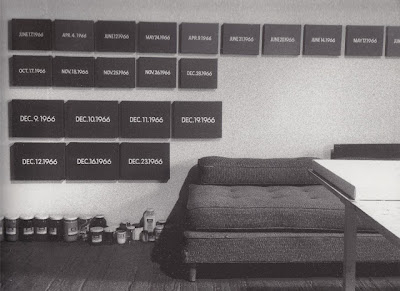 |
Kimimasa Mayama/European Pressphoto Agency
In the two years after Tohoku earthquake, tsunami and nuclear meltdowns, Japan has experienced a new, politically charged era. In some of the largest demonstrations since American-Vietnam war, tens of thousands of antinuclear protesters flooded the streets.In the two years after Tohoku earthquake, tsunami and nuclear meltdowns, Japan has experienced a new, politically charged era. In some of the largest demonstrations since American-Vietnam war, tens of thousands of antinuclear protesters flooded the streets.
|
 |
| Lieko Shiga, Rasen Kaigan, 2011/2012 |
In the widespread destruction, the events of March 11, 2011 damaged several art institutions such as Sendai Mediatheque and Art Tower Mito. Last year
Lieko Shiga displayed starky haunting images created since disaster in the reopened Mediatheque and Art Tower Mito hosted
Artists and the Disaster - Documentation in Progress, records of artists' practical attempts at cleaning up and community rebuilding among which Naoya Hatakeyama's photos of the devastation caused by the tsunami were particularly poignant.
 |
Seige Ono + Ryuichi Sakamoto + Shiro Takatani, Silence Spins, 2012, sound installation.
Photo : Norihiro Ueno. Courtesy Museum of Contemporary Art, Tokyo. |
Japan's museums held numerous memorable exhibitions in 2012. The National Art Center, Tokyo (NACT) held
Gutai - The Spirit of an Era, the movement first survey in Tokyo. The Museum of Contemporary Art Tokyo (MOT) presented the first large-scale Tokyo retrospective of Gutai pioneer Atsuko Tanaka, including her iconic, wearable outfit of painted light bulbs,
Electric Dress. Later in the year composer Ryuichi Sakamoto curated
Art And Music - Search for New Synesthesia, a crossover of the audio and visual works.
 |
| Rinko Kawaguchi, Divinity in the mundane: Untitled, from the Illuminance series 2007 |
National Museum of Modern Art, Tokyo (MOMAT) drew on its collection for the show
Art Will Thrill You! The Essence of Modern Japanese Art, half of which was dedicated to
Mono-ha. At the Tokyo Metropolitan Museum of Photography, Rinko Kawaguchi's solo exhibition included her recent
Illuminace series of eerily lit images of everyday settings. Tokyo private museums often stage the city's best exhibitions. In 2012 Mori Art Museum (MAM) presented Lee Bul, an Asia's leading artist solo show followed by the first survey of art from Middle East and rounded out the year with retrospective of
Makoto Aida, who plays devil's advocate, tweaking his nation's collective conscience by opening a Pandora's box of issues from which most of his compatriots typically avert their eyes.
 |
| Makoto Aida, Path Between Rice Fields, 1991 |
The Watari Museum of Contemporary Art (Watari-um) presented Turning Around, an unusual exhibition of political-activist art curated by Chim ↑ Pom, the Japanese artist group that is itself known for its artistic "brushes" with the law. Last year they added images of Fukushima nuclear power plant, which experienced the meltdown to Taro Okamoto's well-known mural at Shibuya station in Tokyo.
Tokyo Opera City Gallery featured Kishin Shinoyama's portraits of celebrities while next door, the NTT InterCommunication Center examined the relevance of the internet for new-media and conceptual artists such as exonemo and Akihiko Taniguchi in Internet Art Future: Reality in Post Internet Era.
 |
| Koji Enokura, Wall, 1971, gelatin silver print |
Located in a converted warehouse in Kiyosumi, one of the citie's densest cluster of top galleries, Taka Ishii Gallery held solo show of
Tomoo Gokita's surreal, black-and-white abstract painting followed by
Documentation, photographs of Koji Enokura's ephemeral Mono-ha sculptures from 1960s to 1980s. While Tomio Koyama Gallery exhibited photographs and sculptures by another Mono-ha artist Kishio-Suga. Next door, Ai Kowada Gallery hold the show of Futoshi Miyagi's videos and photographs exploring guy identity in Okinawa. In nearby Bakurocho, Radium exhibited Kentaro Haruyama's sleek geometric sculptures of metal, plastic and wood fragments while Zenshi presented sound installation by Hidekado Goto.
In Tokyo's neighboring metropolis of Yokohama, Yokohama Museum of Art hosted retrospective of Yoshimoto Nara. North of the capital, the Museum of Modern Art Saitama held
The '70s in Japan: 1968-1982 survey of art, graphic design, architecture, photography, theatre, music and manga.
On November 3 in Kobe opened the
Yokoo Tadanori Museum of Contemporary Art, dedicated to the veteran graphic-designer-turned-artist. Further to the west, the Hiroshima City Museum of Contemporary Art ended 2012 with survey of Fluxus member
Ay-O while the National Museum in Osaka held the exhibition of Aiko Miyanaga naphthalene sculptures, which gradually degrade at the room temperature.
 |
| Ay-O, Finger Box, 1963-66, wood and mixed media |
Outside Japan, in New York, Museum of Modern Art (MoMA) held
Tokyo 1955-1970: A new Avant-Garde exhibition that encompassed Gutai, Hi Red Center, Jikken Kobo and Mono-ha. David Zwirner Gallery exhibited On Kawara's date paintings while Gary Snyder Gallery showed an installation by Taadaki Kuwayama, and Fiedman Benda presented Tadanori Yokoo new collages. In Midtown
Tatsu Nishi enclosed Christopher Columbus monument in the temporary room. On the West Cost, Naoya Hatakeyama had his first US solo exhibition at the San Francisco Museum of Modern Art while in Los Angeles, Blum&Poe held
Requiem for the Sun: The Art of Mono-ha. Looking ahead to 2013, the Museum of Modern Art in Kamakura will hold the exhibition of Jikken Kobo and Gutai artist will be subject to New Yorks's Guggenheim show
Splendid Playground. In June, Koki Tanaka will represent Japan at Venice Biennale.



.jpg)
.jpg)













































